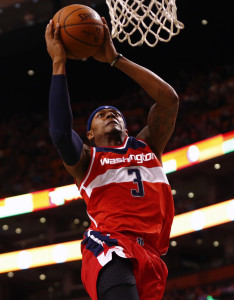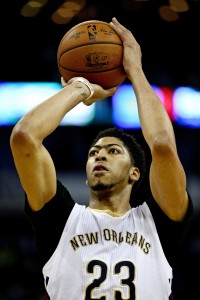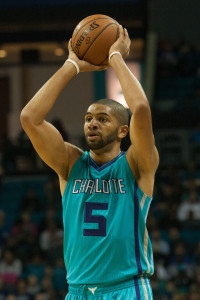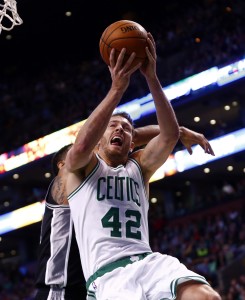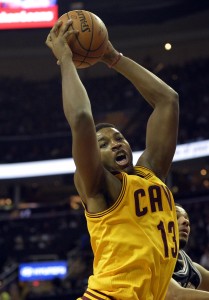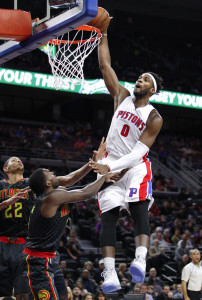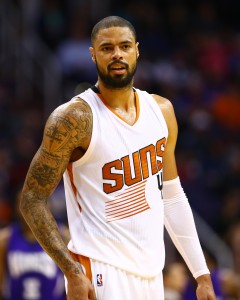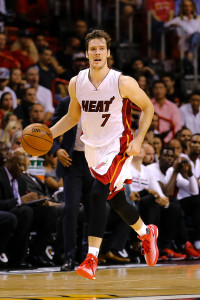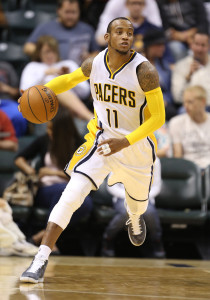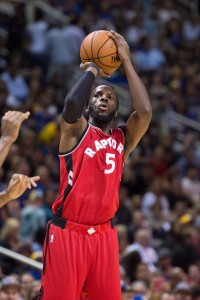Hoops Rumors is in the process of looking back at each team’s offseason, from the end of the playoffs in June right up until opening night. Trades, free agent signings, draft picks, contract extensions, option decisions, camp invitees and more will be covered as we examine the moves each franchise made over the last several months.
Signings
- Alan Anderson: One year, $4MM. Signed via mid-level exception.
- Drew Gooden: Two years, $6.847MM. Signed via Early Bird rights. Second year is non-guaranteed.
- Gary Neal: One year, $2.1MM. Signed via biannual exception.
- Jaleel Roberts: One year, $525K. Signed via minimum-salary exception. Partially guaranteed for $10K. Waived.
Extensions
- None
Trades
- Acquired the draft rights to Kelly Oubre Jr. (No. 15 overall) from the Hawks in exchange for the draft rights to Jerian Grant (No. 19 overall) and Washington’s 2016 and 2019 second round picks.
- Acquired Jared Dudley from the Bucks in exchange for Washington’s 2020 second round pick (top-55 protected).
Waiver Claims
- None
Draft Picks
- Kelly Oubre (Round 1, 15th overall). Signed via rookie exception to rookie scale contract.
- Aaron White (Round 2, 49th overall). Signed overseas.
Camp Invitees
- Josh Harrellson — waived.
- Jaron Johnson — waived.
- Toure’ Murry — waived.
- Ish Smith — waived.
Departing Players
Rookie Contract Option Decisions
- Otto Porter (fourth year, $5,893,981) — exercised
The last two seasons for the Wizards have ended with the team ousted in the second round of the playoffs, which raises legitimate concerns about the current state of their roster as well as the overall direction of the franchise. The window of contention can be fleeting in the NBA, and Washington is in danger of remaining stuck in the difficult position of being good enough to make the playoffs, but not necessarily talented enough to advance to the Conference Finals and beyond.
After what was a rather low-key offseason, the team returns the bulk of its core from 2014/15, with the most significant change being the departure of Paul Pierce, who opted to sign a three year deal worth approximately $10MM with the Clippers. While Pierce is no longer the player that he was in his heyday with Boston, he certainly provided the team with a strong veteran presence, and he was a reliable clutch performer. For that, he will surely be missed. But now that Pierce has departed, it opens the door for Otto Porter, the No. 3 overall selection in the 2013 NBA draft, to step up and prove his value to the club. The Wizards predictably exercised Porter’s fourth-year rookie option, giving him two seasons to establish himself as a player in the league, and as a part of the Wizards’ rotation, in advance of his next contract.
The franchise spent the bulk of the summer looking ahead, not to the 2015/16 season, but rather the summer of 2016, which is when Washington, D.C., native Kevin Durant is eligible to become an unrestricted free agent. While this tactic may end up making this season seem like a bit of an afterthought for the team, it will certainly be looked back on as an extremely wise plan if Durant does indeed end up with the Wizards. A trio of John Wall, Bradley Beal, and Durant would instantly become one of the most electric offensive units in the league, and that dream is certainly worth chasing for the team and its fans.
A key facet of the Wizards’ plan to snare Durant is the timing of when the team inks Beal to a new contract. The 22-year-old was eligible to sign a rookie scale extension prior to this year’s November 2nd deadline, but no deal was worked out, and the franchise opted for cap flexibility rather than the security of knowing the up-and-coming shooting guard was locked down for the long-term. The shooting guard believes he is worth the maximum salary, and Washington fully intends to re-sign Beal for the max next summer, as Sean Deveney of The Sporting News wrote.
With Beal not signing an extension, the Mark Bartelstein client will be able to negotiate with other teams next summer when he becomes a restricted free agent, but the Wizards can match any offer sheet he might agree to. Beal could also take the drastic, and unlikely, step of signing his qualifying offer, which would be worth approximately $7.471MM, but that would represent a significant discount from his projected maximum salary of $20.4MM. Beal had gone on record saying that he was confident about working out a deal with the Wizards before the extension deadline but would be OK with either outcome, and he has no desire to play for another team, as he told Michael Lee of Yahoo Sports.
The Wizards are apparently using the same strategy that the Spurs employed with Kawhi Leonard that allowed them to sign LaMarcus Aldridge this past offseason, and one that the Pistons and Andre Drummond are also pursuing. Both franchises had decided against extensions for their young stars in an effort to preserve cap flexibility for next summer. Beal’s cap hold for the coming offseason will be $14.2MM, and that number will remain on the team’s books until the two sides sign a new contract. If the team had signed Beal to a max extension prior to the deadline, it would have added roughly an additional $6MM to Washington’s cap figure, a significant impediment if the team hopes to land Durant and supplement its roster with a respectable supporting cast. Now, thanks to Beal remaining unsigned, the Wizards could sign other free agents next summer via cap space and then use Bird rights to re-sign Beal or to match an offer sheet for him.
The franchise didn’t completely ignore this year’s squad, signing combo guard Gary Neal and swingman Alan Anderson to one-year, team friendly deals. While both players are solid veterans who provide the team with depth, neither are game-changers for the Wizards. Anderson has yet to play during the regular season, thanks to undergoing a procedure late in training camp to address a nagging issue in his left ankle. The swingman is expected to be out until December and may have already lost his expected spot in the rotation thanks to the strong early play of Porter, though Jorge Castillo of The Washington Post told us that it’s more likely Anderson takes over the minutes that Garrett Temple and Kelly Oubre Jr. are seeing.
Washington also attempted to compensate for the loss of Pierce with the acquisition of Jared Dudley from the Bucks in exchange for a heavily protected 2020 second-round pick, and with Oubre, the No. 15 overall pick in this year’s NBA draft. Dudley was a wise addition, with the veteran certainly capable of providing solid minutes if he can remain healthy. Wizards GM Ernie Grunfeld also made a solid move in acquiring Oubre’s draft rights from the Hawks in exchange for two future second-rounders and the No. 19 overall pick. Oubre is a project who will take some time to develop, but he also possesses lottery-level talent, and he could evolve into a two-way force if the front office and the coaching staff show proper patience.
Washington is a franchise with enough talent to be a factor in the Eastern Conference this season, though the team likely doesn’t have enough firepower to beat the Cavaliers without a generous amount of good fortune coming its way. That’s a major reason why the franchise is anxiously awaiting its shot at luring Durant, whose presence alongside Wall and Beal would instantly make the Wizards a force to be reckoned with. The danger is in focusing too much on Durant, who isn’t necessarily going to depart Oklahoma City, and not doing all that it can to upgrade the roster this season.
The Basketball Insiders salary pages were used in the creation of this post.
